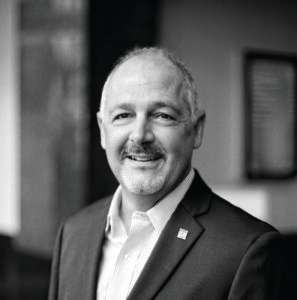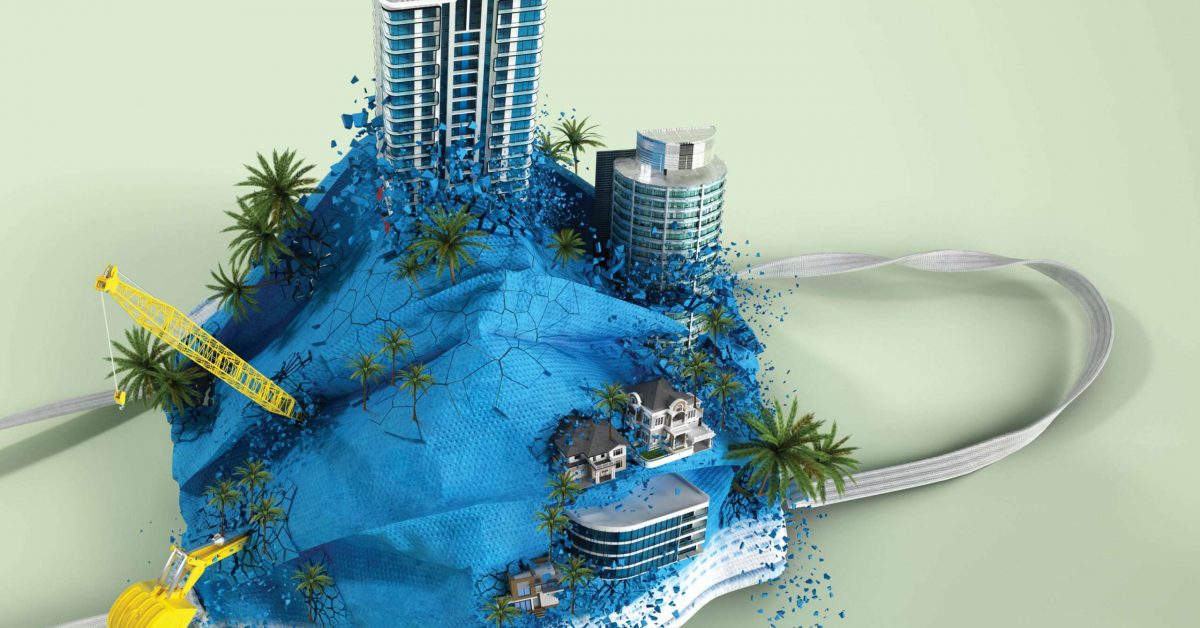Lead Image: Illustration by Sinelab
Travel back to the beginning of 2020, and everything was looking pretty good on the Southwest Florida real estate scene.

Todd Gates
“It was the best economy we’ve all been in,” says Todd Gates, chairman of Gates Construction, a Bonita Springs-based construction management, general contracting and design-build firm that works throughout the Southeast United States and Latin America. The company had dozens of projects in the works, in sectors including health care, hospitality, industrial and education.
Over on the residential real estate side, the picture was positive, as well. In Collier County (excluding Marco Island), for example, closed sales were up 29 percent and pending sales had increased 43 percent in February 2020 compared with February 2019, according to figures from the Naples Area Board of Realtors.

Adam Vellano
“Our local markets were very healthy,” says Adam Vellano, vice president/secretary of NABOR and west coast sales manager for BEX Realty. “We had a balanced inventory and activity was very good.”
Then, everything changed. “It was like a light switch that got turned off,” says Gates. He’s referring, of course, to the COVID-19 pandemic and the business shutdowns and social distancing requirements put in place during the spring of 2020 to help combat it. The Southwest Florida real estate sector was suddenly facing a lot of unknowns, just like all kinds of businesses across the state, country and world.
But the outlook for real estate in Southwest Florida isn’t as gloomy as it could be. While the economic recovery from the pandemic might take longer than people want, and the experience could cause long-lasting societal changes, locals who work in the real estate business find lots to be optimistic about, especially since the situation differs a great deal from the Great Recession of 2007-2009.
“It wasn’t economic conditions that created it; it wasn’t a housing crisis that created it,” says Vellano. “It’s hard to think that coming out of this we’re going to just be awful. I actually think it could be the other way.”
Residential Rebirth?
The COVID-19 pandemic definitely had some early impacts on the residential real estate sector in Southwest Florida. In Lee County, active listings were down 22.6 percent for single-family homes and 23.4 percent for condos and townhomes in March 2020 compared with March 2019, while new pending sales were down 21.8 percent for single-family homes and 32.9 percent for condos and townhomes over that same time-frame. In Collier County, overall pending sales decreased by 38.1 percent, and overall inventory dropped by 27.5 percent in March 2020 compared with March 2019.
“We had some sellers who were taking homes off-market because they didn’t want people in their homes if they were occupied,” says Kevin Williamson, president-elect of Lee County’s Royal Palm Coast Realtor Association and a Realtor with Realty World in Lehigh Acres.
On the other side of the equation, some buyers who were in good shape before the pandemic ran into problems with mortgages after they got laid off or furloughed.
But by mid-April, the initial wave of sellers pulling listings from the market and the decrease in pending sales had subsided, said Matthew S. Simmons, a principal at Fort Myers commercial and residential appraisal and consulting firm Maxwell, Hendry & Simmons. And even in early April, he was still seeing residential real estate sales and purchases, noting that hundreds of residential properties had gone under contract in the area during that period, 11 of which were in excess of $2 million.
“There were still people making decisions to purchase property,” says Simmons. “Families still need a home and people still want to plan for the future.”
Florida is always a place where people plan for their future, whether they’re retirees, second-home purchasers or a family looking for a new adventure. And no one sees that changing any time soon. In fact, the nation’s collective experience of hunkering down at home could increase the Sunshine State’s popularity.
“I bet there are plenty of folks in densely populated northern cities where it was cold and dreary who would have much preferred to be sheltering in place poolside in Southwest Florida,” says Shelton Weeks, director of the Lucas Institute for Real Estate Development & Finance at Florida Gulf Coast University. “There are probably a lot of folks thinking, ‘We’ve been thinking about moving to Florida anyway; as soon as this is over, let’s move.’ I think the things that made us a great place to live all along will help us come out of this.”
That includes assets such as our quality of life and favorable tax climate. And as more people become used to working remotely, they may gain flexibility to work from anywhere they want to live.
“There was already a trend toward remote work as it was, and this has been like pouring gasoline on the fire,” says Simmons. “That’s going to be a positive for Florida. I could see more people than normal relocating here simply because they can.”
With residential inventory already on the low side before the pandemic, no one sees a dramatic slide in prices as long as demand remains. Closings likely will take longer to finalize, though, and contracts may include “COVID riders” to cover any unexpected events.
“This is a health crisis, not a financial crisis, and the good news is the building industry went into this solid,” says Randy Thibaut, founder and CEO of LSI Companies, a Fort Myers real estate brokerage and development firm. “There wasn’t a lot of over-building; there weren’t a lot of spec or unsold new homes out in the market. There will be no better time for buyers to buy a new home with the incentives they’ll be able to achieve and also super-low interest rates.”
It bears watching whether an extended economic shutdown eventually causes any uptick in foreclosures. And if unemployment remains high for a long time, first-time buyers may have more difficulty entering the market. “Last time we had a big downturn here, it took several years for those folks on the cusp of becoming first-time homebuyers to get themselves into the position where they were ready to make that commitment again,” says Weeks.
New home features could become important after this period of time. “We’ve heard from some luxury builders getting calls from people who, after cohabitating during this, now have different needs for their homes and the way they live,” says Thibaut. “It could be more privacy for a husband and wife as they live in a home, or maybe even some larger homes or new spaces built as a result of that.”
Changes to Commercial
Gates’s 40-something projects are still continuing despite the challenges created by the pandemic. “All of the economic indicators that were there before we got shut down are still there,” he says. “It’s just a matter of getting back to normal.”
But that “normal” may be very different than what we were all used to before COVID-19. The retail sector obviously stands to come out of this the most changed, as customers accelerate already existing trends toward online shopping, and some small businesses (and maybe even larger ones) don’t make it out of the pandemic.
But nobody is predicting the death of traditional retail. According to figures from the U.S. Census Bureau, ecommerce retail sales in the fourth quarter of 2019 made up 11.4 percent of total retail sales.

Gary Tasman
“Even if we double the amount of online transactions as opposed to brick-and-mortar transactions, there’s still a very strong need for retail,” says Gary Tasman, CEO and principal broker of Cushman & Wakefield Commercial Property Southwest Florida. “I haven’t found a good alternative to being able to go to Publix and look at the produce and pick out what I want. I’m not saying there’s not a place for online retail; I definitely believe it’s going to continue to grow and create competition for brick-and-mortar retailers. But that’s going to be better for both. Where there’s competition, you always get the best outcomes.”
Don’t be surprised to see changes in the way retail space looks. “Think about the demand in a shopping center for parking,” says FGCU’s Weeks. “The way we’ve historically allocated that may change. We may have fewer spaces than we used to have before and have a significant pickup line. Things like that are going to change because of our experience.”
Restaurants will also have to navigate both economic challenges and societal changes as 2020 progresses. New thinking around space planning will become important as restaurants
address both social distancing needs and the financial bottom line necessary for profitability. And expect the takeout and delivery trend to continue growing, especially as customers remain wary of gathering in groups of strangers.
“How quickly do we get back to comfort in a place like a Dave & Buster’s, where there’s movement everywhere and a ton of high-touch surfaces and close proximity with people?” asks Simmons. “It’s going to be consumers who decide to open up economically, and I don’t know when people are going to want to pile into the local bar and be shoulder to shoulder with people on a Friday night.”
There was still commercial real estate activity in Southwest Florida even in April, when most people would have expected things to be pretty quiet. Tasman says his brokers were as busy in mid-April as they were in mid-February. “There is so much dry powder, so much money in the market waiting to be placed or trying to be placed in investments,” he says.

Bruce Micciche
Bruce Micciche, a broker at LandQwest Commercial Real Estate Services in Southwest Florida, said a 15-unit apartment building he listed in April received 200 inquiries in less than a week. “People who had projects in the pipeline have every intention of seeing them through,” he says. “They may have hit the pause button a little bit, but they’re not checking out. There are still buyers.”
The senior living sector was hot in Southwest Florida before the pandemic, and that trend is expected to continue. “Everyone is going to keep getting old,” says Gates. “Everyone still needs a place to live when it comes to continuing care and memory care. That is not going to change.”
The industrial sector also was chugging along before the health crisis, and it’s expected to stay strong on the other side of it, especially as the need for distribution centers to support online shopping continues to grow. The I-75 corridor will be a hot spot for industrial growth, especially in the Alico Road-Ben Hill Griffin Parkway zone.
Growth in the industrial sector will also come from an increased interest in manufacturing. “If you were trying to look forward, I don’t think I would be the first person to say there will be
increased interest in certain manufacturing operations that we had just farmed out and are now realizing we don’t have the supply chain to support a disaster situation,” says Simmons.
And service-related industries also will spur demand for industrial space. “Landscaping needs to be maintained and pools need to be maintained,” says Adam Palmer, principal/ managing director at LandQwest. “I see a lot of flex product in the industrial sector still being very active, if not more active than before.”
When it comes to office space in Southwest Florida, that’s another area that could see some longer-term changes. Much like the residential side of things, some companies may decide to abandon crowded, expensive cities, and Southwest Florida could benefit from that.
“There may be a real emergence of secondary and tertiary office product as people look to get into a little bit less dense of a residential and professional area,” says Palmer. “They’re starting to analyze the cost of living and quality of living here versus areas such as New York or Chicago and finding it to be a great alternative.”
What that office space looks like will likely change, although exactly how and how much remains to be seen. “Is it smaller spaces because there are more remote workers?” asks Simmons. “Or larger spaces for people who no longer want to be on top of each other?”
If the “six-foot rule” becomes the norm, Tasman expects that to drive an interest in new development, where it will be easier to incorporate things such as high-tech ventilation and filtration systems and voice- or app-operated elevators than to retrofit an existing building.
“This has got a lot of people thinking about grabbing door handles and what materials we can put in buildings that do not attract or maintain viruses of any kind,” says Gates. “We’ll start seeing a whole market blossom on making buildings more antivirus-prone, if you will. We’re the United States. We’re entrepreneurs, and there will be things that will be developed that we haven’t even thought about today that will help us.”
While there’s no doubt that COVID -19 will have impacts on Southwest Florida’s commercial real estate market, almost everyone working in it remains optimistic about its future.
“It’s not going to be like it was,” says Tasman. “You can’t go back in time. It’s going to take an adjustment. We’re different than we were before the Great Recession. The businesses that were thriving then aren’t necessarily the same businesses that are thriving now. Habits and patterns and desires that were strong back then aren’t necessarily the same ones that are now.
“But I’m going to go out on a limb here and say that I think that by Q4 2020 we’re going to be in really good shape.”






